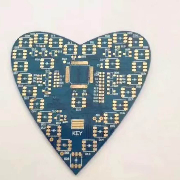High-frequency PCBs require specific materials to ensure reliable performance in signal transmission at elevated frequencies. These materials must have stable electrical properties, low loss, and good signal integrity. Here’s an overview of the most commonly used materials for high-frequency PCBs:
1. PTFE (Polytetrafluoroethylene)
Common Brand Names: Teflon, Rogers 4000 series
Properties: PTFE-based materials have a low dielectric constant (Dk) and low loss tangent (Df), which reduces signal loss, making them ideal for high-frequency applications.
Applications: Microwave and RF (Radio Frequency) circuits, satellite communication, automotive, aerospace, and wireless applications.
Challenges: PTFE materials c...
High-frequency PCBs require specific materials to ensure reliable performance in signal transmission at elevated frequencies. These materials must have stable electrical properties, low loss, and good signal integrity. Here’s an overview of the most commonly used materials for high-frequency PCBs:
1. PTFE (Polytetrafluoroethylene)
Common Brand Names: Teflon, Rogers 4000 series
Properties: PTFE-based materials have a low dielectric constant (Dk) and low loss tangent (Df), which reduces signal loss, making them ideal for high-frequency applications.
Applications: Microwave and RF (Radio Frequency) circuits, satellite communication, automotive, aerospace, and wireless applications.
Challenges: PTFE materials can be difficult to work with due to their high processing temperatures and the need for special equipment.
2. Ceramic PCBs
Common Types: Alumina, Aluminum Nitride, Beryllium Oxide
Properties: Ceramic materials offer very low dielectric loss and high thermal conductivity, which is essential for high-frequency and high-power applications. These materials also have excellent thermal stability.
Applications: Used in high-power RF applications, radar systems, medical devices, and automotive electronics.
Challenges: Ceramics are brittle, so they can be difficult to handle during manufacturing, and their cost is usually higher compared to standard PCB materials.
3. Rogers Laminates
Common Products: Rogers 4003C, 4350B, 5880
Properties: Rogers materials are widely used for high-frequency PCB applications due to their consistent electrical performance, low loss, and high reliability. The Dk values for Rogers laminates can be tailored to meet specific design requirements.
Applications: Aerospace, RF amplifiers, GPS, and telecommunications.
Challenges: They are typically more expensive than standard FR4 and may require specialized fabrication techniques.
4. FR-4 with Epoxy Resin and Glass Fiber
Properties: FR-4 is the most common material for standard PCBs, but there are variations specifically designed for high-frequency applications. These FR-4 versions are modified to have better performance in the GHz frequency range by using higher-quality epoxy resins and specialized glass fibers.
Applications: FR-4 high-frequency versions are used in lower-cost RF applications, consumer electronics, and embedded systems.
Challenges: While cheaper than PTFE or ceramics, FR-4 is not ideal for the highest frequencies and can experience higher signal loss at very high frequencies.
5. Polyimide
Properties: Polyimide materials offer good mechanical properties, high-temperature resistance, and stable electrical performance at higher frequencies. It is often used for flexible PCBs, which can be crucial in high-frequency applications where space is tight.
Applications: Used in applications where flexibility is required, such as mobile phones, wearable electronics, and aerospace systems.
Challenges: Polyimide materials can be more expensive and may require specialized manufacturing techniques, especially for flexible high-frequency applications.
6. PTFE and Glass Fabrics (Hybrid Materials)
Properties: Hybrid materials that combine PTFE with glass fibers or ceramics can further enhance the performance characteristics of a PCB. The glass fibers help improve the mechanical strength of PTFE, which is otherwise relatively weak.
Applications: Used in applications where both electrical performance and mechanical strength are important, such as RF circuits and high-frequency communication systems.
Key Factors in Choosing High-Frequency PCB Materials:
Dielectric Constant (Dk): A material’s Dk affects signal propagation speed and impedance. For high-frequency applications, you need materials with stable Dk values.
Loss Tangent (Df): This measures the material’s ability to dissipate energy. Low-loss materials are critical to minimizing signal degradation.
Thermal Stability: High-frequency PCBs can generate heat, so thermal conductivity and stability are vital in material selection.
Mechanical Strength: For high-frequency applications, materials must withstand mechanical stresses during manufacturing and operation.
Conclusion:
When selecting materials for high-frequency PCB design, it’s important to consider not only the electrical properties but also factors like thermal performance, mechanical stability, and cost. PTFE and Rogers laminates are popular for high-end applications, while ceramics and polyimide materials are used in specialized high-performance environments.
If you need further details or have any specific application questions, feel free to ask!



